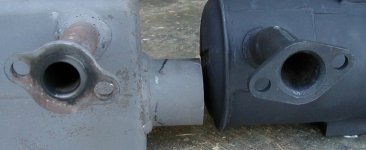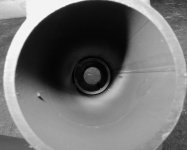SnowRidge
Elite Member
About a month ago, I finally bit the bullet and bought a new Kohler muffler to replace the PT built job that came with the PT-425. I chose the same OEM kind MR's machine came with--a rear discharge model with heat shield and mounting kit. With delivery it was just under $100.
I have never really understood the rational for the PT designed and built air cooled muffler that came on some of the Kohler equipped machines, and may come on the current Robin powered models for all I know. For those reading this who are not familiar with the muffler, it is a rectangular, boxy thing. Like most everything PT built, it is a massive, heavy plate steel weldment. In addition to the usual exhaust input and output tubes, there is an air intake tube.
The intake and output tubes are coaxial, with the intake as the inner tube. A venturi effect sucks fresh air into the left side of the muffler and mixes it with the hot exhaust gasses resulting in a reduced temperature exhaust which exits on the right side of the machine.
According to what I have read, this was done to lower the engine compartment temperatures, but I don't see how that could work since the exhaust gasses are blasted directly out the right side through the cover mesh.
The muffler itself certainly isn't cool. It easily gets hot enough to catch dry grass on fire.
I have been concerned for some time that the Power Trac built muffler had back pressure problems, resulting in the engine running hotter than it otherwise would. Originally, I was going to rig a setup to measure the back pressure and see if it was within limits or not, but I never got around to it, and with the summer heat rapidly approaching, I decided not to risk taking the time to do it.
After running the machine for a month with the new muffler, here is what I have found.
1. It's slightly noisier with a bit sharper tone. I actually prefer it, since I can sense the engine RPM better through the shooting muffs I wear when mowing. It is certainly not objectionably loud.
2. Power seems to have improved slightly, but only slightly. I am a little puzzled by this, considering the other results.
3. Fuel consumption has dropped dramatically. One particular regular mowing job used to take about 4/5 of a tank. It has dropped to a consistent 2/3 of a tank, roughly a 20% improvement.
4. Run-on is no more. Before, no matter what throttle setting we used, we got significant run-on at shut down, unless we let it idle for at least 30 seconds. Even then, we often got it, especially on a hot day. Now we get none, even if we just shut down immediately. Yesterday I mowed for three straight hours in 96 degree temperatures and still go no run-on at shut down.
5. The under the hood temperature seems no higher, and the battery isn't any hotter than before.
6. The hydraulic cooler air flow isn't any hotter, but the flow seems to have a little more volume. Perhaps this is due to the round muffler disrupting the air flow less than the boxy PT muffler.
The attached photo shows the manifold openings of the two mufflers. The PT muffler is on the left. You can see that the Kohler muffler has larger, smoother openings. The PT muffler is under sized, apparently to use a standard pipe size.
It's a little hard to tell in the photo, but the PT muffler's welding is sloppy and the pipe isn't centered in the flange properly.
The output end of the PT muffler has problems, too. See my next post.
I have never really understood the rational for the PT designed and built air cooled muffler that came on some of the Kohler equipped machines, and may come on the current Robin powered models for all I know. For those reading this who are not familiar with the muffler, it is a rectangular, boxy thing. Like most everything PT built, it is a massive, heavy plate steel weldment. In addition to the usual exhaust input and output tubes, there is an air intake tube.
The intake and output tubes are coaxial, with the intake as the inner tube. A venturi effect sucks fresh air into the left side of the muffler and mixes it with the hot exhaust gasses resulting in a reduced temperature exhaust which exits on the right side of the machine.
According to what I have read, this was done to lower the engine compartment temperatures, but I don't see how that could work since the exhaust gasses are blasted directly out the right side through the cover mesh.
The muffler itself certainly isn't cool. It easily gets hot enough to catch dry grass on fire.
I have been concerned for some time that the Power Trac built muffler had back pressure problems, resulting in the engine running hotter than it otherwise would. Originally, I was going to rig a setup to measure the back pressure and see if it was within limits or not, but I never got around to it, and with the summer heat rapidly approaching, I decided not to risk taking the time to do it.
After running the machine for a month with the new muffler, here is what I have found.
1. It's slightly noisier with a bit sharper tone. I actually prefer it, since I can sense the engine RPM better through the shooting muffs I wear when mowing. It is certainly not objectionably loud.
2. Power seems to have improved slightly, but only slightly. I am a little puzzled by this, considering the other results.
3. Fuel consumption has dropped dramatically. One particular regular mowing job used to take about 4/5 of a tank. It has dropped to a consistent 2/3 of a tank, roughly a 20% improvement.
4. Run-on is no more. Before, no matter what throttle setting we used, we got significant run-on at shut down, unless we let it idle for at least 30 seconds. Even then, we often got it, especially on a hot day. Now we get none, even if we just shut down immediately. Yesterday I mowed for three straight hours in 96 degree temperatures and still go no run-on at shut down.
5. The under the hood temperature seems no higher, and the battery isn't any hotter than before.
6. The hydraulic cooler air flow isn't any hotter, but the flow seems to have a little more volume. Perhaps this is due to the round muffler disrupting the air flow less than the boxy PT muffler.
The attached photo shows the manifold openings of the two mufflers. The PT muffler is on the left. You can see that the Kohler muffler has larger, smoother openings. The PT muffler is under sized, apparently to use a standard pipe size.
It's a little hard to tell in the photo, but the PT muffler's welding is sloppy and the pipe isn't centered in the flange properly.
The output end of the PT muffler has problems, too. See my next post.

